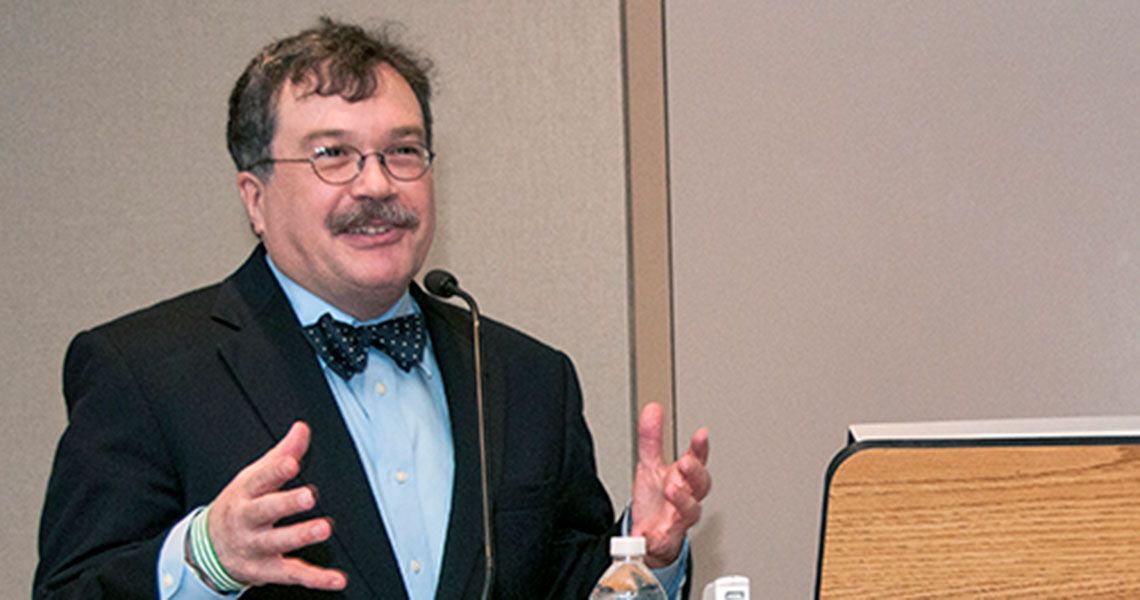Internationally recognized expert on Neglected Tropical Diseases (NTDs), Peter Hotez, M.D., Ph.D., returned to GW’s School of Medicine and Health Sciences (SMHS) May 14 to serve as the 8th Annual Alpha Omega Alpha (AΩA) Visiting Professor. Hotez, who left SMHS four years ago to become the inaugural dean of the National School of Tropical Medicine and head of the Section of Pediatric Tropical Medicine at Baylor College of Medicine, delivered the annual AΩA Grand Rounds lecture.
The lecture serves as the unofficial kickoff to the weekend’s commencement ceremonies and gives the GW chapter of the national medical honor society the opportunity to host a national leader to address issues relating to science, the art of medicine, and professional values.
Hotez — who also serves as president of the Sabin Vaccine Institute, co-founder of the Global Network for Neglected Tropical Diseases, and United States Science Envoy — presented remarks titled “Vaccinating Against Poverty, War, and Neglected Diseases,” focusing on efforts to create vaccines for hookworm infection, schistosomiasis, and Chagas disease, illnesses affecting hundreds of millions of children and adults worldwide.
As the United Nations Millennium Development Goals initiative winds down to its conclusion at the end of 2015, Hotez offered an update on one of the eight goals outlined by the UN: Combating HIV/AIDS, malaria, and other diseases. Citing the study Global Burden of Disease, which evaluated the effects of massive investment and development assistance projects such as the President's Emergency Plan for AIDS Relief (PEPFAR), the President’s Malaria Initiative, and the Global Fund to Fight AIDS, Tuberculosis (TB), and Malaria, Hotez reasoned the results, in terms of HIV/AIDS and malaria, look optimistic. “The numbers for malaria are particularly impressive,” he said. “There were 233 million cases in 2004, and that has gone down to 165 million cases, or a 30 percent reduction of cases.”
For NTDs, however, there is still more ground to cover. Ascariasis, or intestinal roundworm, leads the global list of NTD infections with 819 million cases, more than three times as many cases as HIV/AIDS, malaria, and TB combined, according to World Health Organization data.
Ironically, the lack of lethality among most NTDs, argued Hotez, is a possible explanation for why these diseases are neglected in the first place. NTDs are not commonly killer infections; rather, they are debilitating disorders that trap the world’s poor in a chronic cycle of illness and poverty. As a result, NTDs fail to rouse the public conscious. NTDs are shaving IQ points off of children, and they are preventing people from thriving and fulfilling their full potential, but they aren’t killing them. “We have economists,” said Hotez, “who have calculated that chronic hookworm infection can lead to a 40 percent reduction in future wage-earning. The economic impact seems to be a very persuasive argument.”
In the fall of 2014, the Ebola virus outbreak in West Africa garnered tremendous media attention. For Hotez and others invested in tropical medicine, the outbreak and ensuing media coverage typified the struggle to direct public attention to more significant threats to public health. In the heart of the outbreak — Guinea, Liberia, and Sierra Leone — Ebola affects fewer than 0.1 percent of the population, but virtually everyone has some type of NTD. “That is a tough message to get across,” said Hotez. He joked that during the October Ebola media blitz when he appeared on cable news channels almost daily, his interviews were invariably cut short the instant he suggested there were more pressing health concerns in the region.
“You can imagine what would happen when I would go on MSNBC or Fox News and they would ask, ‘Doctor, aren’t you worried about Ebola coming to America?’” said Hotez. “I would say ‘No. Here is what we know about transmission rates for the Ebola virus. I am worried about 12 million Americans living with NTDs.’” That, he added, typically prompted a “Thank you doctor, but we’re out of time.”
In war-ravaged regions such as North Africa, the Middle East, and Central Asia, conflict overburdens, or virtually dismantles, the health care infrastructure, as it did in Libya, Liberia, Syria, Iraq, and Afghanistan, among other conflict nations. While these countries account for just 20 percent of the global population, they represent most of the world’s cases of Leishmaniasis and half of the cases of river blindness. That, Hotez explained, is because NTDs have as much to do with conflict as they have to do with poverty.
“This is not something new,” explained Hotez. “In the 1970s, we saw a re-emergence of sleeping sickness in Angola and Congo because of the conflict there. We saw that again with southern Sudan in the 1980s, where more than 100,000 people died of neglected diseases, actually five times more than the number who died in the Ebola epidemic.”
Understanding the link between conflict and NTDs, Hotez predicted that Syria, Iraq, and Yemen were ripe for catastrophic NTD outbreaks. Already in northwestern Syria, Cutaneous Leishmaniasis, transmitted by sand flies and known locally as “Aleppo Evil,” for Syria’s largest city, is affecting in the area. “They’ve seen 100,000 new cases in the last 18 months. With the breakdown of infrastructure, the flies have been allowed to proliferate, and they are following the refugees across the border.”
In closing his remarks, Hotez updated the audience on the Sabin Institute’s hookworm vaccine trials and explained the critical nature of vaccine development, both therapeutic and preventative, in addressing diseases of poverty and crisis. “Who is going make the next generation of countermeasures for these diseases?” asked Hotez. The lack of value as a profit center, he added, is stunting their development.
The Ebola vaccine is a perfect illustration of that. The basic sciences had been completed long before the 2014 outbreak, but there was nobody available to finance development or distribution to the infected region. “The Ebola vaccine was published by Gary Nabel and colleagues from the Vaccine Research Center in 2003,” said Hotez. “What happened was it sat there for a decade while we waited.” Typically, a large pharmaceutical company licenses the vaccine for production. It was only when the disease reached crisis proportions and there was sufficient financial incentive through government agencies that the Ebola vaccine received the backing to enter clinical testing and development. By the time it was ready for clinical trials, explained Hotez, the crisis was ending. “This was an absolute failure of the system. It wasn’t a technological failure; it was a market failure. The technology has outpaced our political, social, and financial institutions.”



